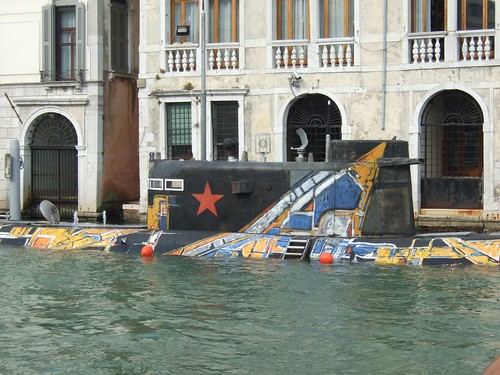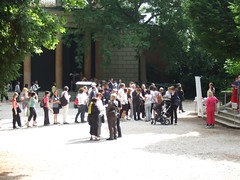[You can also find this on the BBC News website, of course]
The 53rd Venice Art Biennale has just opened, a massive exhibition of contemporary art from around the world that takes over large parts of the city every two years from June to November and turns it into a showcase for the new, the experimental, the exciting and the just plain weird.
And I do mean weird.
 There’s a semi-submerged Russian submarine in the Grand Canal, an Icelandic artist is going to spend the next six months painting a series of bad portraits of a cigarette-smoking model, and a group of Nordic artists are exhibiting a very life-like corpse floating face-down in a swimming pool while a group of naked men sit on deckchairs nearby.
There’s a semi-submerged Russian submarine in the Grand Canal, an Icelandic artist is going to spend the next six months painting a series of bad portraits of a cigarette-smoking model, and a group of Nordic artists are exhibiting a very life-like corpse floating face-down in a swimming pool while a group of naked men sit on deckchairs nearby.
Seventy-seven countries are taking part, many of them exhibiting their work in purpose built pavilions in the public gardens of the Giardini while others can be found in the former shipyard of the Arsenale or scattered across palaces and warehouses throughout the city.
As well as the national pavilions there are forty-four associated exhibitions and events, and nearly one hundred individual artists have been invited to show work in the central ‘Making Worlds’ exhibition.
The four days before the opening day are the vernissage, when entry is reserved for curators, artists, politicians, collectors – especially the wealthier ones – and, at the bottom of the pecking order, journalists.
And because so much contemporary art depends on digital technology for its creation or display, since 2005 I’ve been invited to go to Venice with the producer and presenter of the World Service radio programme Digital Planet to make a biennial special about the Biennale and the many ways technology is affecting artistic practice.

Four days is not nearly enough time to see everything, of course, but some careful reading of the catalogue and the press releases put out by the participating countries offers an initial sense of what is going on, and fortunately there are many opportunities to share insights and ideas with friends and colleagues over drinks in a bar or on a crowded vap0retto between venues.
While there was a lot of interesting art, I saw little that attempted to explore our use of or reliance on technology itself, and the only two pieces I encountered that seemed to have any connection to digital technology for its own sake were rather disappointing as neither was actually working when I visited.
The animatronic cat in the German pavilion didn’t move at all, while a movement sensor that was supposed to turn off the ultraviolet lights shining on Alexey Kallima’s mural ‘Rain Theorem’ in the Russian pavilion, making the sports crowd he has painted on the wall disappear as you walk towards it, didn’t seem to notice I was there. I was left waving my hands in the air in a piece of impromptu performance art that clearly failed to impress the other people in the room.
I didn’t see any work that tried to engage with the internet, either. In 2007 Sophie Calle explored the power of communication through email, but this time I didn’t spot anything similar, and neither Dropstuff.org’s online art show or the grand ‘Internet Pavilion’ are part of the official festival.
One area where digital technology has had a massive impact on the art world is of course in film and video, where high definition video cameras and editing tools are being used by many artists to create moving image work, and it was here that I really felt the impact of the new technologies. There seemed to be more screen-based work than in 2007, and in general I felt that the artists using video had chosen it because they had something to say, and not – as in the past – because it was a cool new toy to play with.
The Biennale isn’t all video, of course. Dave Moutrey, director of Manchester’s Cornerhouse arts centre, told me that he had seen a lot more painting than last time, so I’ve clearly been selecting work that might have a ‘digital’ theme and missing the paintings and sculptures.
The high points included the artfully constructed short films of Canadian artist Mark Lewis, who uses back projection to induce a sense of perceptual dislocation in the viewer, and the the expertly constructed explorations of the nature of belief and evidence for psychic phenomena from Susan MacWilliam in the Northern Ireland pavilion, as well as Shaun Gladwell’s elegiac and touching depictions of the outback in the Australian Pavilion.
I was also taken aback by ‘Dark Days’, John Cale’s astonishing, evocative and painfully honest attempt to explore his Welsh past, an audio-visual work that uses the cavernous space of a former brewery to amazing effect.
One reason the screen-based work is more impressive than 2007 is, I think, because the technology itself has improved so much. The cameras available to video-based artists today aren’t just high-definition, they also have much better image processing electronics built into them, so what they capture is richer and offers more to work with.
The editing tools are two or three generations on from those used last time, too, and of course the hardware has more than doubled in speed, meaning that editing is more fluid and large jobs like rendering a final version of a piece can be done much faster, encouraging more experimentation on the part of the artist.
And the actual presentation is enhanced by the high-intensity projectors that are now commercially available. As Mark Lewis explained, this meant he could show his work to an acceptable quality in the glass-fronted Canadian pavilion, while John Cale’s work was so clear you could see the rain falling across the valley in his slowly panning views of Wales.
The new technologies may offer exciting tools to work with and new ways of reaching audiences, but they can also have unexpected side effects when an artist wants to create an aura of mystery around their work.
Although Steve McQueen has tried to create an aura of mystery around his film ‘Giardini’, which is showing in the English pavilion, the beautifully shot sequences of life in the Biennale gardens when the show has left town lose some of their mystery when anyone who wants can search Flickr for similar photos taken by many other people, including a set I shot myself in December 2007. In art, as in journalism and politics, the network brings down boundaries and encourages openness, and this poses a significant challenge to those who rely on mystery, obfuscation or secrecy in any sphere.
The Digital Planet Venice special wass broadcast on Tuesday 8th June. Details on the programme page. It is also podcast.
Bill’s Links
Biennale home page:
Digital Planet’s take in 2005:
Review of Giardini:
Bill’s Flickr set:
Mark Lewis:
Susan MacWilliam:
Shaun Gladwell:
John Cale:
Alexey Kallima:
